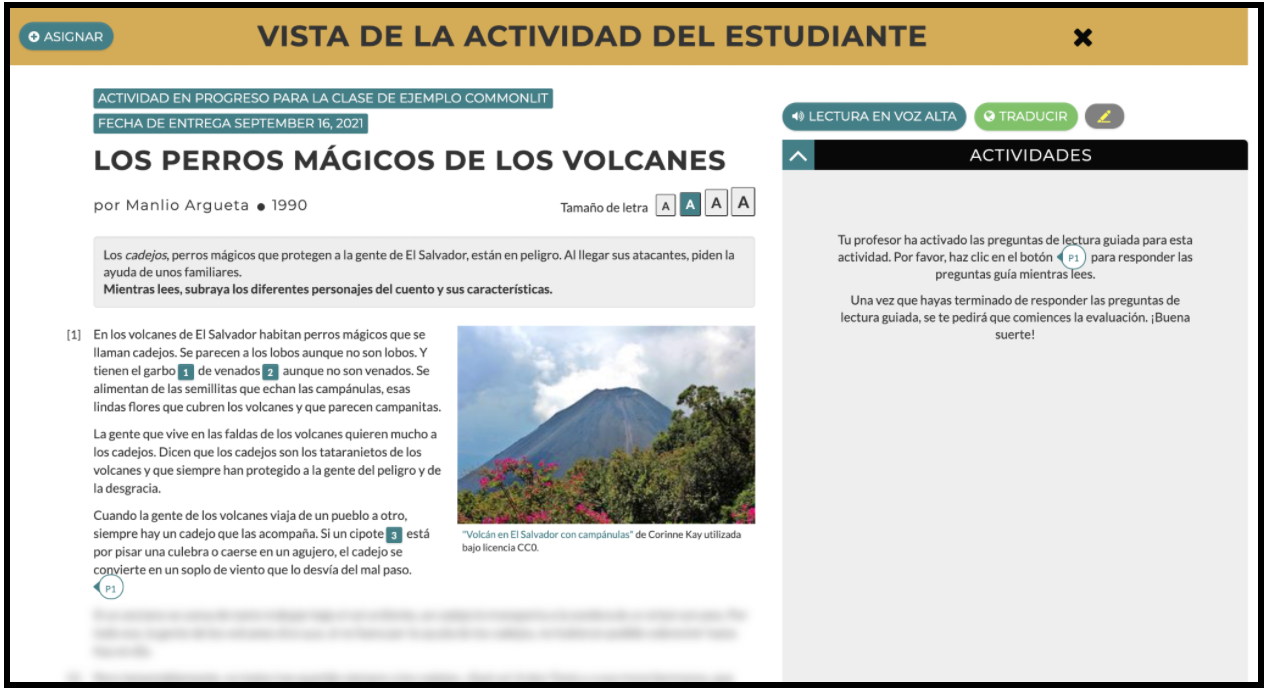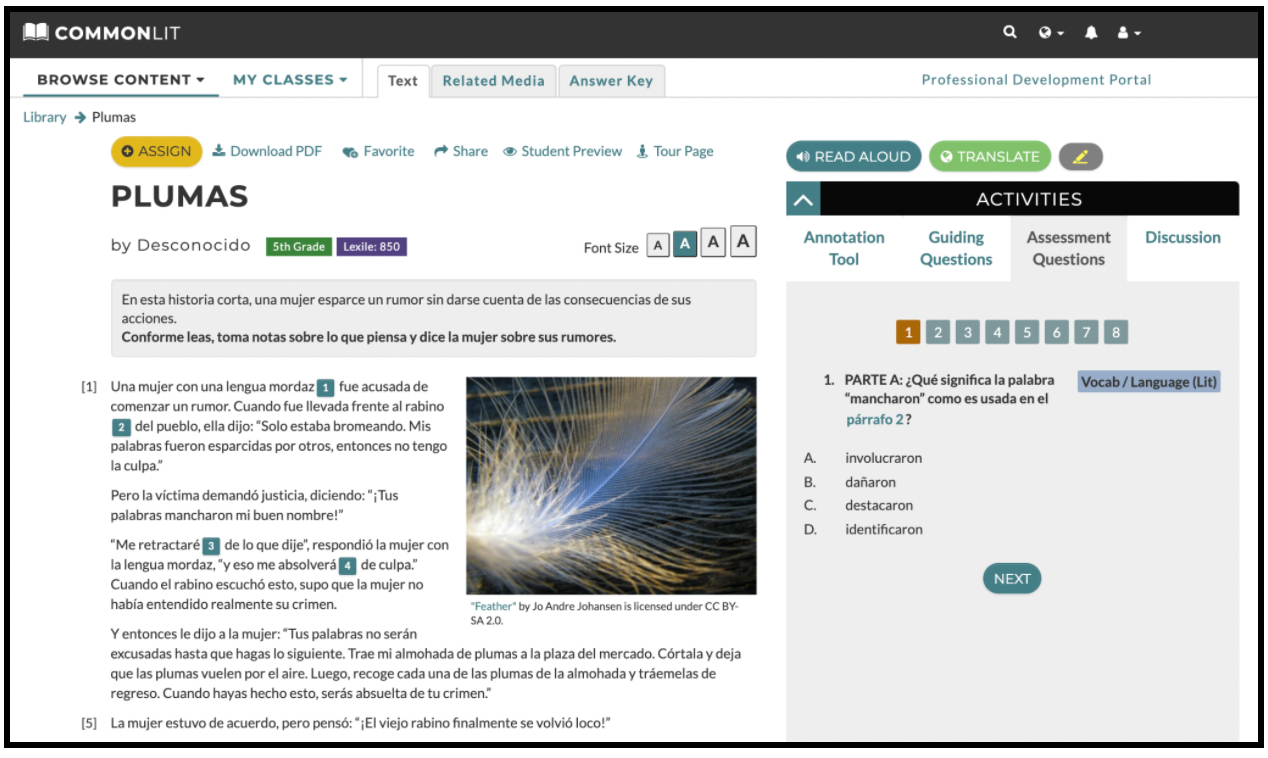 CommonLit Español
Engaging Short Stories in Spanish for Elementary, Middle, and High School Students
CommonLit Español
Engaging Short Stories in Spanish for Elementary, Middle, and High School Students
CommonLit offers great short stories in Spanish that teach important lessons about family, identity, courage, and more
Short stories are an enjoyable entry point into the world of high-quality literature. They can introduce students to relatable characters, new cultures, and important ideas. Reading short stories with your students is a great way to promote discussion, encourage them to make connections, and have them practice using skills that will help them understand more complex texts.
Here is an engaging set of short stories in Spanish from CommonLit for grades 3–9. This diverse selection includes realistic fiction, science fiction, mysteries, and more!
“Mi bisabuela” by Nancy Machlis (3rd grade)
In this short story, the narrator and her brother Zach visit their great-grandma in a nursing home. Great-Grandma struggles with memory loss, and Zach is upset when she doesn’t remember him. The narrator comforts her brother by reminding him of Great-Grandma’s words: “Love is a light in your heart that lives forever.” When it is time to leave and Great-Grandma smiles at her, the narrator is reminded that even as her great-grandmother’s memory fades, the love in their hearts still ties them together.
While students read, have them follow the annotation task, which asks them to take notes on how the children feel when they visit their great-grandma. Then, have students use their notes to make text-to-self connections. Students can compare and contrast how they feel when they spend time with older relatives with how the children in the story feel.
“Los perros mágicos de los volcanes” by Manlio Argueta (4th grade)
In this folktale, the cadejos are magical dogs that live in volcanoes and protect the people of El Salvador. When Don Tonio and his thirteen brothers bring soldiers to attack the cadejos, the dogs seek help from two ancient volcanoes. The volcanoes fight off the soldiers to protect the cadejos, Don Tonio and his brothers flee, and the cadejos and the people of El Salvador celebrate a great festival that later becomes a national holiday.
Consider turning on Guided Reading Mode while students read to ensure they understand the characters’ motivations. Guided Reading Mode chunks the text into smaller pieces with a comprehension question after each section. Students must answer each comprehension question correctly to reveal the next chunk of text. Guided Reading Mode is a great way to help students monitor their own comprehension as they read!

“Galapagueña” by Marsha Diane Arnold (4th grade)
In this short story, Valentina loves the Galápagos Islands where she lives. She spends her days exploring, swimming, and dancing. Valentina especially enjoys watching the various animals that call the islands home. When she gets older, Valentina leaves the island to study biology, but eventually comes back to the Galápagos to share her love for the island and its wildlife with others.
After reading, discuss what makes the Galápagos Islands so special to Valentina. Ask Discussion Question 2, “Según la autora, las Islas Galápagos son especiales. ¿Cuál de sus características te parece más especial? ¿Por qué?” In English, the question is, “According to the author, the Galápagos Islands are special. Which of its characteristics do you find the most special? Why?” Be sure to encourage students to support their thinking with evidence from the text.
“Plumas” by Unknown (5th grade)
In this meaningful short story, a woman is accused of starting a rumor about someone. When she speaks with the town rabbi, she claims that the rumor spreading is not her fault, because it was others who spread it. The rabbi decides to teach the woman an important lesson about kindness. He asks her to cut open his pillow, let the feathers inside fly through the air, then collect each of the feathers and bring the pillow back. The woman follows the rabbi’s directions and finds that she cannot re-capture all of the feathers. She realizes that, just like the feathers cannot be caught again, words cannot be taken back once spoken, and she vows to speak kindly from then on.
In fifth grade, students are learning how to navigate relationships with peers, so this text provides a great opportunity to have them make connections to their own lives. Ask students to discuss the importance of speaking kindly to others. Students can give evidence and examples from the text and from their own experiences to support their thinking.

“Aurelia y los colores” by Amaranta Castelán González (6th grade)
Aurelia is a skilled artist and an insect lover, but she is not much of an athlete. When Aurelia and her cousin Paula go to summer classes together, Aurelia excels in art class but is teased by two boys in physical education, who laugh at her when she plays soccer. Later, when Aurelia captures a tarantula to show her classmates, the boys are impressed by her knowledge of insects. Aurelia realizes that everyone has different strengths and abilities and that she should be proud of her unique skills.
It is important for middle school students to develop strong self-esteem and celebrate their own talents. Sixth graders may recognize themselves in Aurelia, who has trouble seeing the value of her own strengths when she struggles with other skills. Ask students Discussion Question 2, “¿A ti te gustan todas las clases o hay algunas que no te gustan tanto? ¿Y a tus amigos les pasa algo similar? ¿Hay actividades en las que eres más talentoso?” to start a conversation about how everybody has strengths and areas for growth. In English, the question is, “Do you like all your classes or are there some that you don’t like as much? Do your friends experience something similar? Are there activities at which you are very talented?”
“En los rápidos” by Bradford H. Robie (7th grade)
In this thrilling short story, Luis falls into a river during a rafting trip. He is terrified and knows he has to rely on his own skills and strength to survive. Luis remembers the guide’s instructions and thinks of how he stayed calm during a basketball game at school. He swims hard to make it back to the raft, where the guide is finally able to pull him out of the water.
While reading, have students follow the annotation task, which asks them to take notes on Luis’s attitude as he tries to save himself. Encourage students to make connections between Luis’s thoughts and actions. After reading, students can share how Luis’ determination helped him survive.
“La inspiración” by Pablo de Santis (8th grade)
In this engaging story, famous detective Sage Feng is summoned to solve the mystery of the death of Siao, the poet who lived in the Chinese emperor’s palace. Feng examines Siao’s belongings and asks the imperial advisor if Siao had any enemies. In the end, the detective is able to figure out that one of Siao’s rivals put poison in the monkey-hair brush he used to write his poetry.
Author Pablo de Santis plants several clues throughout the text, and students will get caught up in trying to solve the mystery of Siao’s death along with Feng. After reading, use Discussion Question 1, “Al leer el cuento por primera vez, ¿Cómo te sentiste al final? ¿Te sorprendió la resolución de la historia?” to start a conversation about the resolution of the story. In English, the question is, “When reading the story for the first time, how did you feel at the end? Were you surprised by the resolution of the story?” Encourage students to use evidence from the text to support their answers.

“El peatón” by Ray Bradbury (9th grade)
In this dystopian science fiction story set in the future, writer Leonard Mead is out for an evening walk in an unnamed city. He is stopped by police, who ask questions about his purpose for walking, his job as a writer, and why he does not own a TV like the rest of the people in this technology-dominated society. The police determine that because of Mr. Mead’s “regressive” view of technology, he must be brought to a psychiatric center, and they take him away.
This short story provides an opportunity to start an interesting discussion about technology and society with your students. Mr. Mead’s career as a writer is not valued where he lives because nobody in his city buys books or magazines anymore. Ask Discussion Question 2, “En el texto, ¿de qué modo los progresos tecnológicos impactaron la manera en que las personas interactúan en nuestra sociedad? ¿Cuáles son algunos otros ejemplos de cómo la tecnología ha tenido impacto en la interacción humana?” to have students share ideas about the benefits and drawbacks of technology in society today. In English, the question is, “In the text, how have technological advances affected the way people interact in society? What are some other examples of how technology has affected human interaction?”
Next Steps
Looking for more Spanish texts on CommonLit? Browse the CommonLit Español library!
If you’re interested in learning all about CommonLit’s free Spanish digital literacy program, join one of our upcoming webinars!
If you are an administrator looking to leverage CommonLit in your school or district, our partnerships team can help. We offer benchmark assessments, professional learning, and more!

